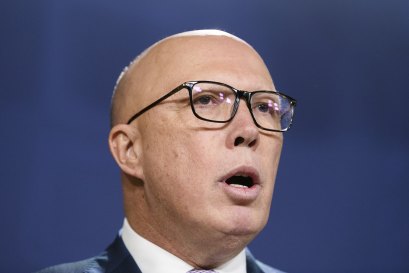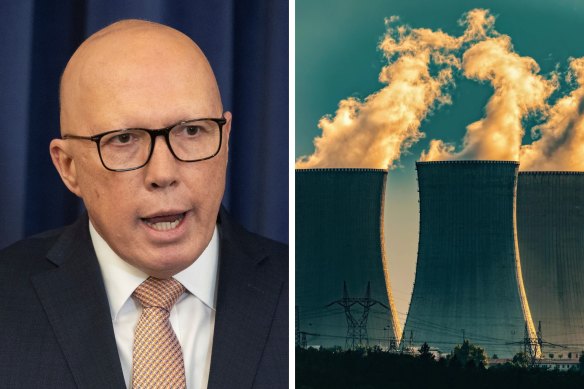This was published 8 months ago
‘You couldn’t make this up’: Expert pans Ontario nuclear option
By Bianca Hall and Nick O'Malley
Ontario subsidises its citizens’ electricity power bills by $7.3 billion a year from general revenue, an international energy expert has said, contradicting the Coalition’s claim that nuclear reactors would drive power prices down in Australia.
Opposition Leader Peter Dutton has repeatedly cited the Canadian province as a model for cheaper power prices from nuclear.

Opposition Leader Peter Dutton has said Australia should follow Ontario down the nuclear path.Credit: Rhett Wyman
“In Ontario, that family is paying half of what the family is paying here in Perth for their electricity because of nuclear power,” Dutton said in March. “Why wouldn’t we consider it as a country?”
In July, Dutton said Canadian consumers paid about one-quarter of Australian prices for electricity.
Professor Mark Winfield, an academic from York University in Canada who specialises in energy and environment, on Monday said the reaction among people in Ontario to the comparison had ranged from disbelief to “you couldn’t make this up”.
Ontario embarked on a massive building spree between the 1960s and the 1990s, Winfield told a briefing hosted by the Climate Council and the Smart Energy Council.
In the process, he said, the provincial-owned utility building the generators “effectively bankrupted itself”. About $21 billion in debt had to be stranded to render the successor organisation Ontario Power Generation economically viable.
In 2015, the Canadian government approved a plan to refurbish 10 ageing reactors, but Winfield said the refurbishment program had also been beset by cost blowouts.
“The last one, [in] Darlington, east of Toronto, was supposed to cost $C4 billion and ended up costing $C14 [billion],” Winfield said.
“And that was fairly typical of what we saw, of a cost overrun in the range of about 2.5 times over estimate.”
In Melbourne, Dutton said while he respected new Queensland Premier David Crisafulli’s opposition to nuclear, he would work with “sensible” premiers in Queensland, South Australia and NSW on his plan, if he was elected.

Opposition Leader Peter Dutton has committed to build seven nuclear plants across the country if he wins the next election.Credit: Alex Ellinghausen, Getty Images
“I think the question that we really need to ask ourselves now is, why is Anthony Albanese standing in the way of a bipartisan position on nuclear energy, which would be zero emissions, it would provide stability, electricity, and it would also make us internationally competitive,” he said.
According to the World Nuclear Association, there are 19 operable nuclear reactors in Canada, mostly in Ontario, which generate about 15 per cent of the country’s energy.
Winfield said household bills were kept artificially low under the Ontario model, despite the high cost of refurbishing ageing nuclear facilities.
“There’s a legacy of that still in the system that we are effectively subsidising electricity bills to the tune of about $C7.3 billion a year out of general revenues. That constitutes most of the provincial deficit; that’s money that otherwise could be going on schools and hospitals.”
Dutton’s comments came as a parliamentary inquiry into the suitability of nuclear power for Australia continued in Canberra. Experts provided evidence on how long it would take to build a nuclear fleet, and the potential cost and impact on energy prices compared with the government’s plan to replace the ageing coal fleet with a system of renewables backed by storage and gas peakers.
Former Australian Nuclear Science and Technology Organisation chief executive Dr Adrian Paterson said he believed Australia could build seven nuclear power plants in 11 years to replace coal in time, and that doing so would drive down power prices.
He cited dramatic falls in bills that occurred when Finland switched on its most recent reactor. That reactor, known as Olkiluoto 3, was built alongside two older reactors. It took 17 years to buildand its costs blew out from $5 billion to $18 billion.
In its annual GenCost, CSIRO estimated earlier this year that a single large-scale nuclear reactor in Australia would cost $16 billion and take nearly two decades to build, too late for it to help meet Australia’s international climate change commitments, which requires it to cut emissions 43 per cent by 2030. It found renewables to be the cheapest option for Australia.
Dutton has so far refused to be drawn on the costs of his nuclear policy. Opposition energy spokesman Ted O’Brien said the Coalition would release costings before the next federal election, which must be held by May.
O’Brien told this masthead “expert after expert” had provided evidence that nuclear energy placed downward pressure on power prices around the world.
“For instance, we heard that despite going over budget, the latest Finnish nuclear power plant reduced electricity prices by over 30 per cent once it was turned on,” he said.
“Labor promised to reduce household power prices by $275 but after two years of failed policy, Australians are paying among the most expensive energy bills in the world.
“Australians are now paying up to $1000 more than Labor promised.”
with Lachlan Abbott